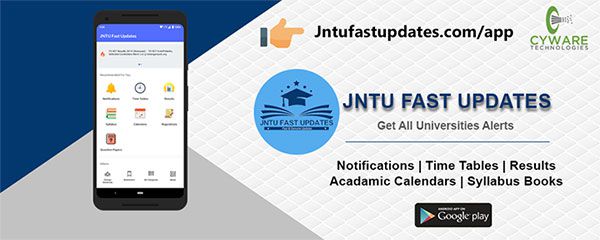JNTUK R20 2-2 Formal Languages and Automata Theory Material PDF Download
Students those who are studying JNTUK R20 CSE Branch, Can Download Unit wise R20 2-2 Formal Languages and Automata Theory (FLAT) Material/Notes PDFs below.

JNTUK R20 2-2 Formal Languages and Automata Theory Material PDF Download
OBJECTIVES:
- To learn fundamentals of Regular and Context Free Grammars and Languages
- To understand the relation between Regular Language and Finite Automata and machines
- To learn how to design Automata’s and machines as Acceptors, Verifiers and Translators
- To understand the relation between Contexts free Languages, PDA and TM
- To learn how to design PDA as acceptor and TM as Calculators
UNIT-1
Finite Automata: Need of Automata theory, Central Concepts of Automata Theory, Automation, Finite Automation, Transition Systems, Acceptance of a String, DFA, Design of DFAs, NFA, Design of NFA, Equivalence of DFA and NFA, Conversion of NFA into DFA, Finite Automata with Є-Transitions, Minimization of Finite Automata, Finite Automata with output-Mealy and Moore Machines, Applications and Limitation of Finite Automata.
Download UNIT-1 Material PDF | Reference-2
UNIT-2
Regular Expressions, Regular Sets, Identity Rules, Equivalence of two RE, Manipulations of REs, Finite Automata and Regular Expressions, Inter Conversion, Equivalence between FA and RE, Pumping Lemma of Regular Sets, Closure Properties of Regular Sets, Grammars, Classification of Grammars, Chomsky Hierarchy Theorem, Right and Left Linear Regular Grammars, Equivalence between RG and FA, Inter Conversion.
Download UNIT-2 Material PDF | Reference-2
UNIT-3
Formal Languages, Context Free Grammar, Leftmost and Rightmost Derivations, Parse Trees, Ambiguous Grammars, Simplification of Context Free Grammars-Elimination of Useless Symbols, Є-Productions and Unit Productions, Normal Forms-Chomsky Normal Form and Greibach Normal Form, Pumping Lemma, Closure Properties, Applications of Context Free Grammars.
Download UNIT-3 Material PDF | Reference-2
UNIT-4
Pushdown Automata, Definition, Model, Graphical Notation, Instantaneous Description, Language Acceptance of Pushdown Automata, Design of Pushdown Automata, Deterministic and Non – Deterministic Pushdown Automata, Equivalence of Pushdown Automata and Context Free Grammars, Conversion, Two Stack Pushdown Automata, Application of Pushdown Automata.
UNIT-5
Turning Machine: Definition, Model, Representation of TMs-Instantaneous Descriptions, Transition Tables and Transition Diagrams, Language of a TM, Design of TMs, Types of TMs, Church’s Thesis, Universal and Restricted TM, Decidable and Un-decidable Problems, Halting Problem of TMs, Post’s Correspondence Problem, Modified PCP, Classes of P and NP, NP-Hard and NP-Complete Problems.
TEXT BOOKS:
- Introduction to Automata Theory, Languages and Computation, J. E. Hopcroft, R. Motwani and J. D. Ullman, 3rd Edition, Pearson, 2008
- Theory of Computer Science-Automata, Languages and Computation, K. L. P. Mishra and N. Chandrasekharan, 3rd Edition, PHI, 2007
REFERENCE BOOKS:
- eference Books: 1) Elements of Theory of Computation, Lewis H.P. & Papadimition C.H., Pearson /PHI
- Theory of Computation, V. Kulkarni, Oxford University Press, 2013
- Theory of Automata, Languages and Computation, Rajendra Kumar, McGraw Hill, 2014
e-Resources:
OUTCOMES:
- Classify machines by their power to recognize languages.
- Summarize language classes & grammars relationship among them with the help of Chomsky hierarchy
- Employ finite state machines to solve problems in computing
- Illustrate deterministic and non-deterministic machines
- Quote the hierarchy of problems arising in the computer science


320-x100(1).gif)

upload r20 pdf’s
upload r20 pdfs
PDFs are not downloading
PDF are not downloading